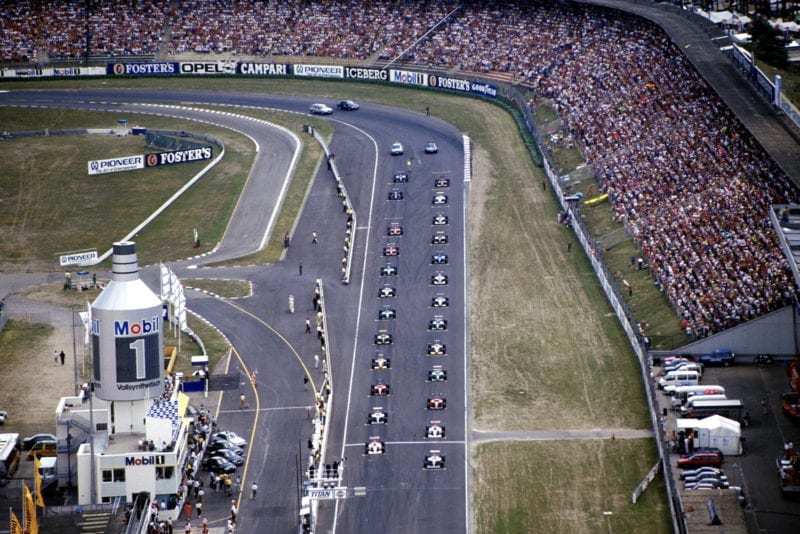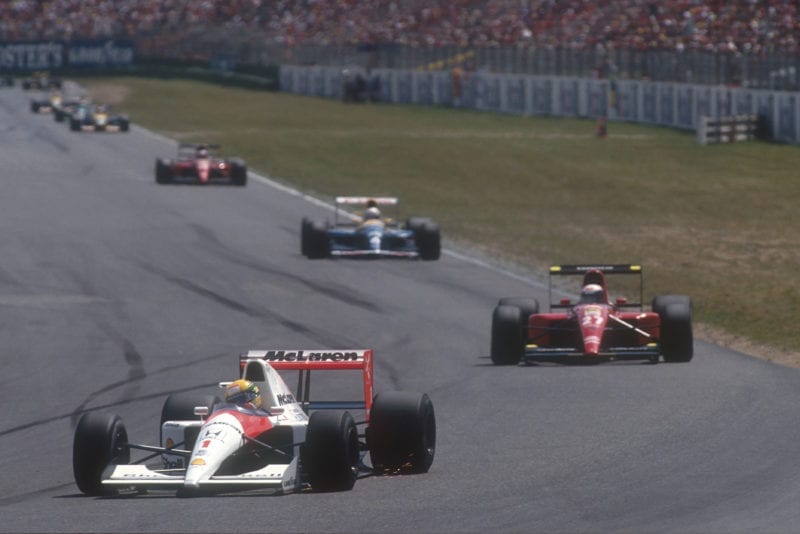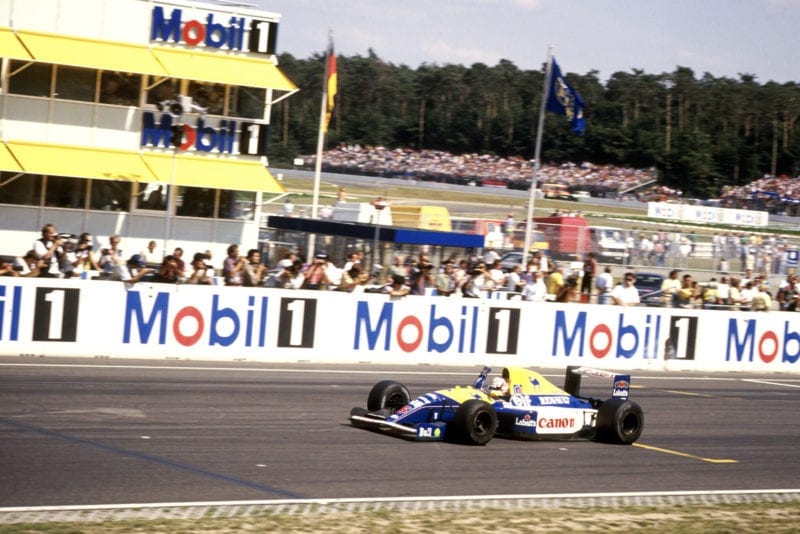Formula One: 1991 German Grand Prix
Another Williams-Renault 1-2
Hockenheimring, July 28th. From the highly successful British Grand Prix at Silverstone the “circus” moved across to Germany, to the very fast but unspectacular Hockenheimring, with its vast stadium containing a Mickey Mouse section of twists and turns, with an outward curving leg interrupted by two artificial chicanes to the far away Ostkurve, with another very fast straight back to the Stadium, with a third chicane in its length. In spite of the Mickey Mouse bit in the stadium, and the three chicanes, the lap record average speed is near to 150 mph. Fast but dull is the best way to sum up the Hockenheimring, but the simple fact of the matter is that there is nowhere else to hold the German Grand Prix.
The once majestic and fearsome Nürburgring has been replaced by a modern facility that nobody seems very interested in, and if you have ever been to the old Nürburgring you will know why.
Before the “circus” spread itself over the vast paddock area there had been some tyre-test sessions, during which the Williams-Renault team showed clearly that their performance at Silverstone was not a flash-in-the-pan. McLaren-Honda had another setback when Ayrton Senna had a monumental accident when a rear tyre burst. The car was a virtual write-off but the Brazilian got away unscathed.

An aerial view of the start of the German Grand Prix
Motorsport Images
When the German Grand Prix meeting got under way at 8am on Friday morning with one hour of pre-qualifying for teams who have a low finishing record over the past twelve months, there was a new scene. The Brabham-Yamaha team, the AGS team and the Footwork team have all been demoted, to join Fondmetal and Coloni. The Jordan team and the Scuderia Italia Dallara team have both earned their promotion, and the works Lamborghini team scraped through more due to the failure of others than any serious success. The two Brabhams, one AGS (Tarquini) and one Footwork (Alboreto) escaped into the event proper, though they were still not guaranteed a place on the starting grid; that was a matter for the serious qualifying sessions. Alessandro Caffi was back in the second Footwork, putting Johannson back on the unemployed F1 list, though the little Italian failed to pre-qualify. He was accompanied by Grouillard (Fomet), Barbazza (AGS) and Chaves (Coloni).
From the moment that the Friday morning test session began, it was Williams-Renault all the way, with Mansell leading and Patrese supporting him nobly, and though McLaren-Honda showed a lot of fight it was not enough to conquer the Didcot-Billancourt partnership. The weather was hot, but the pace was hotter, and in the first afternoon Mansell took provisional pole position with a lap that was nearly three seconds faster than Senna’s pole position last year! The French-powered cars were recording over 210 mph through the Longines-Olivetti speed trap on the way to the first chicane. Ferrari, with three of their new cars, were hardly in the picture, being little more than on the tail of the leading quartet, while the rest of the entry were in a different world. Aerodynamics alone was not going to get anyone near the front, the cars needed to be slippery and powerful and horsepower was the name of the game, as it usually is.
By the time the 26 positions for the grid had been sorted out there had been the usual number of mechanical troubles, a lot of it in the gearbox regions, but engines suffered as well and there were a number of accidents, some minor, some major like Eric Comas who inverted his Ligier-Lamborghini 712 and escaped with a shaking. Prize for disaster must be given to the Footwork team, for after scraping one car through pre-qualifying, all three cars were given Alboreto’s number 9 and in the course of the 1-1/2 hours of Friday morning testing he managed to abandon all three round the circuit, two with transmission breakage and one with a puncture. Jack Oliver was looking at his empty pit-space with a look of disbelief on his face.

Ayrton Senna ahead of Alain Prost, Riccardo Patrese and Jean Alesi
Motorsport Images
At the front of the grid the order was Mansell, Senna, Berger and Patrese with less than half a second covering them, and though Mansell never looked like being beaten the opposition was close. The two Ferraris were on their own, two seconds away from the leading Williams-Renault, and the rest were led by de Cesaris more than 3 seconds away from pole position. With Mansell’s fastest lap being at an average of 156.722 mph, three seconds was an awful long way behind, and the Jordan driver was the best of the rest and ahead of both Benettons, using the same Cosworth V8 engines. The starting grid shows clearly the vast difference between front and back of the grid: more than seven seconds separated pole position from the last non-qualifier, who was averaging around 145 mph for his slow lap! In Saturday morning testing Mansell had put in a lap at 1.36.998, a speed of 156.866 mph, compared with his fastest qualifying time of 1.37.087. The faster cars were passing the pits and main grandstands at over 170 mph, and the stands were very full on both practice days.
Race day proved to be very warm and tyres were obviously going to play a vital part in the outcome of the race, not because of wear or overheating more than normal, but with the closeness of the first four the time spent in the pits was going to be vital.
From the moment the green lights shone it was Mansell all the way! He made a truly dragster-like start and was gone into the first right-hander leading out of the Stadium. Following him, Berger cut across the front of Senna and was away in second place, while Patrese was a bit cautious, remembering what happened at Silverstone, and both Ferraris got ahead of him. Down at the back of the grid Mark Blundell got all sideways at the first corner and there was a lot of hectic dodging about but the only casualty was Larini in the Lambo 2, who took avoiding action and spun off on the grass and stalled his engine. The Larrousse-Lola driver Suzuki had been forced to take the team’s spare car and start from the pit-lane, due to engine trouble, and as he set off he found cars going in all directions! Out in front Mansell was not waiting for anyone and in the opening laps set the pace with laps in the 1m 47s bracket, ten seconds slower than Saturday’s qualifying pace. There are times when F1 looks a bit like endurance racing, except that F1 endurance is barely 1-1/2 hours. Mansell’s pace was the standard for race day and nobody could match it, so he pulled steadily away. Meanwhile Patrese was getting into a proper Williams-Renault style and sailed past Alesi’s Ferrari, which was running on harder Goodyears in the hope of covering the 45 laps non-stop, while everyone else was planning a tyre change. Senna had settled back behind Berger, holding third place with Prost, Patrese and Alesi snapping at his heels. Down at the end of the field Suzuki had made up a lot of ground but his run was short-lived as more engine trouble intervened; his team-mate Bernard had already retired with transmission trouble.

Sparks fly from the back of Nigel Mansell’s Williams
Motorsport Images
A mere 14 laps had passed when Berger was seen heading down the pit-lane to the waiting McLaren mechanics, where the wheel changing went quick enough, but then one of the hub-nuts gave trouble and Berger lost an agonising extra 10 seconds before he was on his way again. For three laps Senna was in second place, but then he stopped for new tyres and he was followed by Prost, so Patrese moved up into second place, and the next lap Mansell was in for tyres and Patrese led on the road. Before he could record an official lap in the lead on the lap charts, he was slowing and turning into the pit lane, so it was Alesi who crossed the timing line first on lap 19, and again on lap 20, while Mansell was regaining the pace after his pit-stop. On lap 21 Mansell was back into the lead, but Patrese had still to catch the young Ferrari driver. This took him until lap 37 and caused him no real problems.
Williams-Renault were now a dominant 1-2 with Alesi in third place, well ahead of Senna, Prost and Berger, so it looked as though the non-stop tactic on hard tyres was going to pay off. In fourth place Senna had Prost fidgeting about behind him, trying to get by at some points on the circuit and falling back on others, while Berger was in sixth place, with little hope of making up for the extra 10 seconds lost at his pit-stop. This was Race number 1. Race number 2 was being run concurrently and was equally busy and interesting, being between the midfield runners, while Race number 3 was for those tail-enders that were still circulating.
Apart from when they stopped for a tyre change, the two Jordans were in complete command of Race 2, de Cesaris dealing with Piquet’s Benetton very early on, and Gachot dealing with Moreno’s Benetton, interspersed with a three-cornered battle when Capelli mixed it with them. Poor Gugelmin never got beyond midfield, troubled by various mechanical defects, retiring before half distance with gearbox trouble. Capelli took the Leyton House-Ilmor V10 battle into the Jordan, Benetton camp with great enthusiasm, until he was sidelined by a misfire that could not be cured, but Moreno could not keep up the pace of the Jordans and soon de Cesaris and Gachot were in 7th and 8th places. Barely had this happened than they were promoted up a place, when Prost went sailing up an escape road and out of the race. He had been trying to out-brake Senna on a number of occasions, and this time he did it, but on the wrong line and over-did it into retirement, complaining his usual way because Senna did not make room for him! He seemed to overlook the factor that they were racing for fourth place and are both experienced enough to look after themselves, or should be. The two Williams-Renault cars were still running fast and consistently out in front, Patrese sharing fastest lap with Mansell in a fine demonstration of reliability and domination, with the McLaren-Honda and Ferrari opposition trailing in their wake. In reality these three teams are the only serious contenders for Race number 1, while the Jordan team yet again took command of Race number 2. For the rest it seems to be a struggle for survival. The Brabham-Yamaha pair had some small satisfaction in finishing, albeit at the back of the list, but it was a small step forward after needing to suffer the ignominy of having to pre-qualify.

Mansell crosses the line to win the 1991 German Grand Prix
Motorsport Images
As Mansell was completing his last lap to lead his team-mate home by a comfortable 13 seconds, there was consternation in the McLaren-Honda pit as Senna was seen to stop on the outward run from the Stadium. Almost unbelievably the McLaren had run out of fuel, as it did at Silverstone. There were no excuses, but it does indicate how fine the margins are with the McLaren-Honda team in their efforts to keep pace with the continually improving Williams-Renault team. The margins are so fine that there is no room for tolerance, everything on the McLaren car and Honda engine is having to be squeezed to the limit to give Senna a car with which to challenge the Williams-Renault, because even then he is no match for Mansell and Patrese with the Anglo-French cars.
A very thoughtful Jean Alesi climbed up onto the winner’s rostrum with the two Williams drivers, well satisfied with his third place and the fact that the gamble had paid off. Senna returned to the paddock too wound up to make a comment and spent a long time in deep discussion with his team. Gerhard Berger finished a distant fourth and just as he finished his slowing-down lap with Capelli riding on his side-pod his car ran dry of fuel, which was exactly right for the McLaren-Honda calculations.
This win and second place by Williams-Renault put the team one point ahead of McLaren-Honda in the Constructors’ Championship, and we can rest assured that they mean to stay there. Team Tyrrell were supposed to be the Honda back-up team but they seem to be failing miserably, one car retiring with gearbox trouble and the other delayed by tyre problems and an engine misfire. As for the Minardi team being back-up for the Scuderia Ferrari team, it has not happened and the idea that Jordan were going to be the Ford Cosworth back-up team to the Benetton-Cosworth team is another joke. Ford put their money on the wrong team and Jordan are really enjoying their position as best of the rest. The question is will the 1992 Ford-Cosworth V12 engine be capable of taking the Jordan team into the big-boys playground? — DSJ
***
Results (top five), German GP, Hockenheimring, July 28
45 laps of 6.802 km circuit (306.090 km; 190.195 miles)
1. Nigel Mansell, GB, (Williams FW14 – Renault V10) 1h 19m 29.661s
2. Riccardo Patrese, I, (Williams FW14 – Renault V10) 1h 19m 43.440s
3. Jean Alesi, F, (Ferrari F1/91B – Ferrari V12) 1h 19m 47.279s
4. Gerhard Berger, AUT, (McLaren MP4/6 – Honda V12) 1h 20m 02.312s
5. Andrea de Cesaris, I, (Jordan 191 – Cosworth V8 HB) 1h 20m 47.198s
Conditions: Hot
Winner’s Average speed: 231.028 kph (143.554 mph)
Fastest Lap: Riccardo Patrese (Williams FW14 -Renault V10) 1m 45.569s on lap 35 : 236,454 kph (146.913 mph).
